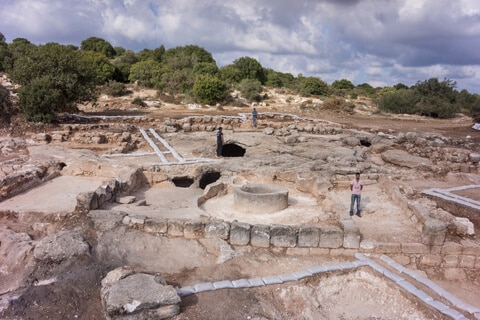Antiquities Authority archaeologist Irena Silberbud from the Antiquities Authority estimates that the place was used as a monastery

The Antiquities Authority has revealed in recent weeks in Ramat Beit Shemesh a large and impressive complex from the Byzantine period, which includes a Gat textile house and mosaics. The excavations were financed by the Ministry of Construction and Housing, and they were done as part of the expansion of the city of Beit Shemesh.
A walking archaeological survey conducted in the hills south of Beit Shemesh, resulted in the discovery of impressive findings. During the survey, blocked cisterns, an opening to a cave, and a few wall heads were seen on the surface. These clues, to the world hidden below the surface of the ground, led to a comprehensive archaeological excavation at the site, which revealed a rich life from the Byzantine period that was not known until now.
The complex is surrounded by an outer wall, and is divided inside into two areas: an industrial area and an activity and residential area. In the industrial area, a textile mill for the production of olive oil was uncovered, impressive in size and rare in its preservation. Outside the built complex, a large wine cellar was uncovered, consisting of two surfaces for treading grapes, from where the must flowed into a large collection pit.
From the findings, it appears that the local residents made wine and oil for their livelihood. Two large baking ovens were also uncovered in their entirety in the compound. The impressive size of the facilities shows that they manufactured and produced produce and products on an industrial scale, and not just for domestic needs.
In the residential area of the complex, several rooms were uncovered, some of which have preserved colorful mosaic floors. The wide rooms were at least two stories high, they were built of fine ashlar stones, their walls were plastered with fine plaster, and the floors were paved with colorful mosaics: one of them is particularly beautiful, it is decorated with a cluster of grapes surrounded by a bouquet of flowers placed in a geometric frame.
Irena Zilberbud and Thila Liebman, who are managing the excavation on behalf of the Antiquities Authority, speculate that this is a complex that was used as a monastery in the Byzantine period. "Although we did not find a church, an inscription or any other distinct ritual evidence at the site, the impressive construction, dating to the Byzantine period, the magnificent mosaic floors, finds of windows and tiles and the agricultural production facilities within the residential complex, are known to us from many other monasteries of the period. If this is the case, then it can be assumed that monks lived in this monastery who lived and made a living from the agricultural facilities."
At a certain point, which can be dated to the beginning of the Muslim period (seventh century AD), the monastery fell out of use, and later it was populated by new residents. These, made changes in his plan, and adapted it to their needs.
Dr. Yuval Baruch, an archaeologist for the Jerusalem region at the Antiquities Authority, notes that after the discovery of the complex and recognition of its importance, the Antiquities Authority and the Ministry of Construction and Housing began taking the necessary measures to preserve the site and develop it as an open archaeological site in the heart of the new neighborhood that is to be built there.
These impressive findings were discovered, as mentioned, for the first time during an archaeological survey.
On this occasion, the Antiquities Authority launches the "Israel Archaeological Survey Site" - a huge online database with 15,000 sites, which for the first time makes accessible - for free and at the click of a button, extensive professional information about The archeological sites in Israel are complete, and near the house. The survey maps that appear on the site reveal to the archaeologist or the traveler what evidence has been uncovered from the ancient worlds that lie beneath his feet. The database is frequently updated with additional survey maps.
